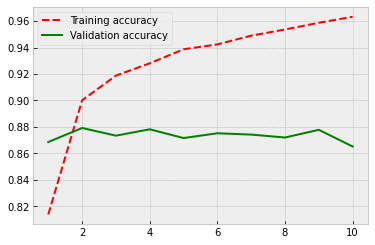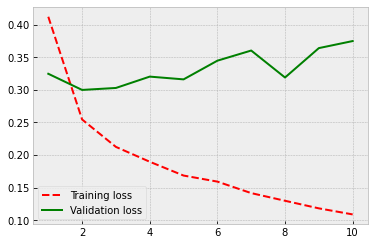3. NLP example - IMDB¶
In this example, we build a simple neural network model to predict the sentiment of movie reviews.
First, we load the IMDB data that is included in the Keras library (part of Tensorflow). Also, we load the preprocessing module.
from tensorflow.keras.datasets import imdb
from tensorflow.keras import preprocessing
This is a dataset of 25,000 movies reviews from IMDB, labelled by sentiment (positive/negative). The reviews have been preprocessed, and each review is encoded as a list of word indexes (integers).
Words are ranked by how often they occur (in the training set) and only the num_words most frequent words are kept. Any less frequent word will appear as oov_char value in the sequence data. If we use num_words = None, all words are kept.
(x_train, y_train), (x_test, y_test) = imdb.load_data(num_words = 10000)
The following commands pad sequences to the same length, in this case, to 20 words.
pad_sequences() creates a 2D Numpy array of shape (number of samples x number of words) from a list of sequences.
x_train = preprocessing.sequence.pad_sequences(x_train, maxlen=20)
x_test = preprocessing.sequence.pad_sequences(x_test, maxlen=20)
x_train.shape
(25000, 20)
y_train.shape
(25000,)
3.1. Densely connected network¶
We first build a traditional densely connected feed-forward-network. We also need an Embedding layer to code our words efficiently and a Flatten layer to transform our 2D-tensor to 1D-vector.
from tensorflow.keras.models import Sequential
from tensorflow.keras.layers import Flatten, Dense, Embedding
Our embedding layer codes 10000 words to 8-element vectors. The output layer has one neuron and a sigmoid-activation function that gives a probability for positive/negative. model.sequential() defines the network type, and the add() -functions are used to add layers to the model.
model = Sequential()
model.add(Embedding(10000, 8, input_length=20))
model.add(Flatten())
model.add(Dense(1, activation='sigmoid'))
Like with the examples of the computer vision section, we can stick with the RMSprop gradient descent optimiser. Because we are doing positive/negative classification, binary_crossentropy is the correct loss function. We measure the model performance with prediction accuracy.
model.compile(optimizer='rmsprop', loss='binary_crossentropy', metrics=['acc'])
The model has 80161 parameters.
model.summary()
Model: "sequential"
_________________________________________________________________
Layer (type) Output Shape Param #
=================================================================
embedding (Embedding) (None, 20, 8) 80000
_________________________________________________________________
flatten (Flatten) (None, 160) 0
_________________________________________________________________
dense (Dense) (None, 1) 161
=================================================================
Total params: 80,161
Trainable params: 80,161
Non-trainable params: 0
_________________________________________________________________
The data is split into training and validation parts with 80/20% division. We go through the data ten times (epochs=10). The data is fed to the model in 32 unit batches and, thus, each epoch has 625 steps (32 * 625 = 20000). Our prediction accuracy with the validation data is 0.75. However, the model appears to be overfitting as the validation loss is increasing, and there is a wide gap between the training accuracy and the validation accuracy in the last epochs.
history = model.fit(x_train,
y_train,
epochs=10,
batch_size=32,
validation_split=0.2)
Epoch 1/10
625/625 [==============================] - 1s 2ms/step - loss: 0.6664 - acc: 0.6326 - val_loss: 0.6148 - val_acc: 0.7040
Epoch 2/10
625/625 [==============================] - 1s 2ms/step - loss: 0.5389 - acc: 0.7514 - val_loss: 0.5266 - val_acc: 0.7302
Epoch 3/10
625/625 [==============================] - 1s 2ms/step - loss: 0.4611 - acc: 0.7863 - val_loss: 0.5022 - val_acc: 0.7434
Epoch 4/10
625/625 [==============================] - 1s 2ms/step - loss: 0.4223 - acc: 0.8091 - val_loss: 0.4948 - val_acc: 0.7552
Epoch 5/10
625/625 [==============================] - 1s 2ms/step - loss: 0.3964 - acc: 0.8225 - val_loss: 0.4934 - val_acc: 0.7582
Epoch 6/10
625/625 [==============================] - 1s 2ms/step - loss: 0.3738 - acc: 0.8342 - val_loss: 0.4964 - val_acc: 0.7578
Epoch 7/10
625/625 [==============================] - 1s 2ms/step - loss: 0.3538 - acc: 0.8462 - val_loss: 0.5011 - val_acc: 0.7562
Epoch 8/10
625/625 [==============================] - 1s 2ms/step - loss: 0.3347 - acc: 0.8584 - val_loss: 0.5081 - val_acc: 0.7564
Epoch 9/10
625/625 [==============================] - 1s 2ms/step - loss: 0.3171 - acc: 0.8663 - val_loss: 0.5143 - val_acc: 0.7548
Epoch 10/10
625/625 [==============================] - 1s 2ms/step - loss: 0.3000 - acc: 0.8749 - val_loss: 0.5226 - val_acc: 0.7516
import matplotlib.pyplot as plt
plt.style.use('bmh')
acc = history.history['acc']
val_acc = history.history['val_acc']
loss = history.history['loss']
val_loss = history.history['val_loss']
epochs = range(1, len(acc) + 1)
plt.plot(epochs, acc, 'r--', label='Training accuracy')
plt.plot(epochs, val_acc, 'g', label='Validation accuracy')
plt.legend()
plt.figure()
plt.plot(epochs, loss, 'r--', label='Training loss')
plt.plot(epochs, val_loss, 'g', label='Validation loss')
plt.legend()
plt.show()
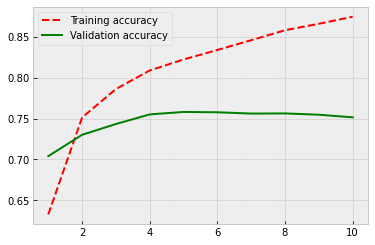
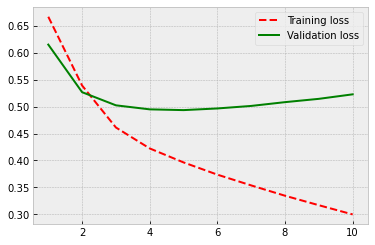
As our first improvement, we could try to use pre-trained embeddings in our model. Word embeddings include semantic information about our words (words appearing in similar contexts are close to each other). Pretrained embeddings are trained using vast amounts of text (billions of words). One could assume that the semantic information in these pre-trained embeddings is of higher quality and should improve our predictions. Let’s see…
To be able to use this approach, we need the original IMBD data. Search for aclimdb.zip from the internet.
import os
My raw data is in the aclImdb -folder under the work folder
imdb_raw = './aclImdb/'
First, we define empty lists for the reviews and their sentiment labels. Then we collect the negative reviews from ./aclImdb/train/neg -folder. We also add to the labels-list zero for these cases. A similar approach is repeated for the positive reviews. Thus, in our lists, we have first the negative reviews and the positive reviews.
labels = []
texts = []
# Collect negative reviews
train_neg_dir = os.path.join(imdb_raw,'train','neg')
for file in os.listdir(train_neg_dir):
f = open(os.path.join(train_neg_dir, file))
texts.append(f.read())
f.close()
labels.append(0)
# Collect positive reviews
train_neg_dir = os.path.join(imdb_raw,'train','pos')
for file in os.listdir(train_neg_dir):
f = open(os.path.join(train_neg_dir, file))
texts.append(f.read())
f.close()
labels.append(1)
Below is an example text and its’ sentiment (0=negative).
texts[0]
'There are some bad movies out there. Most of them are rather fun. "Criminally Insane 1" was one of those flicks. So bad that it was enjoyable and had re-watch value to it. "Criminally Insane 2" has to be one of the worst movies ever made and coming from me, that\'s saying a lot because I am not the type of person to say anything is the worst. But trust me, this was just completely awful and running just 1 hour is 1 hour too long.<br /><br />The movie has a rather incoherent storyline, but who cares about story when all you want to see is a big fat woman running around killing people because she isn\'t being fed. Well, you don\'t see that in this movie, except for all of the flashback sequences that are from the first one. The new storyline could have been really funny with Ethel being sent to a halfway house and murdering everyone in there, but nothing happens until the last 20 minutes of the movie and at that point you are already falling asleep.<br /><br />The camera work in this movie is just atrocious. This literally reminds me of something I shot with friends of mine back when I was 15. The sound quality is something else as you can\'t understand a word most of the characters are saying. To give an example of how bad it is, go into a New York Subway and try to understand what is being said over the loud speakers, that is what this movie sounds like. Not that it matters what they are talking about anyway because the actors are about as dry as a dead piece of wood.<br /><br />Now I know that saying this is the worst movie out there is pretty harsh but words can\'t describe just how bad this movie is. If you don\'t believe me, see it for yourself. 1/10'
labels[0]
0
We need Numpy and text-processing tools from the Keras libary.
from tensorflow.keras.preprocessing.text import Tokenizer
from tensorflow.keras.preprocessing.sequence import pad_sequences
import numpy as np
The following commands tokenise words into vectors.
tokenizer = Tokenizer(num_words = 10000)
tokenizer.fit_on_texts(texts)
The following commands transform each text in texts to a sequence of integers.
Only words known by the tokenizer will be taken into account. It will take into account only the 10000 most frequent words.
sequences = tokenizer.texts_to_sequences(texts)
Now, we use longer texts. We keep the 200 first words from each review.
data = pad_sequences(sequences, maxlen=200)
The following command transforms the labels list to a numpy array.
labels = np.asarray(labels)
data.shape
(25000, 200)
labels.shape
(25000,)
Because the reviews are in order (all the negative reviews first and then the positive reviews), we have to shuffle the data before feeding it to the model.
indices = np.arange(25000)
np.random.shuffle(indices)
data = data[indices]
labels = labels[indices]
80 / 20 % separation of the data to training and validation parts.
x_train = data[:20000]
y_train = labels[:20000]
x_val = data[20000: 25000]
y_val = labels[20000: 25000]
The Stanford NLP group offers GLOVE pre-trained embeddings. You can download them from nlp.stanford.edu/projects/glove/. We use the glove6B.zip that is trained using 6 billion tokens. Each word is represented as a 100-dimensional vector.
# we use 100-dimensional vectors
embeddings_index = {}
f = open(os.path.join('./glove.6B/', 'glove.6B.100d.txt'))
for line in f:
values = line.split()
word = values[0]
coefs = np.asarray(values[1:], dtype='float32')
embeddings_index[word] = coefs
f.close()
GLOVE has 400k tokens.
len(embeddings_index)
400000
We build the embedding matrix by going through our word index and adding its’ embeddings from the Glove model (if it is found).
embedding_matrix = np.zeros((10000, 100))
for word, i in word_index.items():
if i < 10000:
embedding_vector = embeddings_index.get(word)
if embedding_vector is not None:
embedding_matrix[i] = embedding_vector
Because our model uses now 100-dimensional word vectors, the network also has a lot of more parameters. Our network also has a new 32-neuron dense layer after the Flatten-layer.
model = Sequential()
model.add(Embedding(10000, 100, input_length=200))
model.add(Flatten())
model.add(Dense(32, activation='relu'))
model.add(Dense(1, activation='sigmoid'))
model.summary()
Model: "sequential_5"
_________________________________________________________________
Layer (type) Output Shape Param #
=================================================================
embedding_5 (Embedding) (None, 200, 100) 1000000
_________________________________________________________________
flatten_3 (Flatten) (None, 20000) 0
_________________________________________________________________
dense_7 (Dense) (None, 32) 640032
_________________________________________________________________
dense_8 (Dense) (None, 1) 33
=================================================================
Total params: 1,640,065
Trainable params: 1,640,065
Non-trainable params: 0
_________________________________________________________________
We set the weights of the embedding layer using the Glove weights in the embedding matrix. The weights need to be locked so that we are not retraining them with our small dataset.
model.layers[0].set_weights([embedding_matrix])
model.layers[0].trainable = False
Again, we use the RMSprop optimiser, the binary_crossentropy loss function and accuracy as our performance metric.
model.compile(optimizer='rmsprop',loss='binary_crossentropy',metrics=['acc'])
history = model.fit(x_train, y_train,epochs=10,batch_size=32,validation_data=(x_val, y_val))
Epoch 1/10
625/625 [==============================] - 2s 3ms/step - loss: 0.6591 - acc: 0.6439 - val_loss: 0.5575 - val_acc: 0.7138
Epoch 2/10
625/625 [==============================] - 2s 3ms/step - loss: 0.5045 - acc: 0.7554 - val_loss: 0.5326 - val_acc: 0.7366
Epoch 3/10
625/625 [==============================] - 2s 3ms/step - loss: 0.4155 - acc: 0.8091 - val_loss: 0.5454 - val_acc: 0.7398
Epoch 4/10
625/625 [==============================] - 2s 3ms/step - loss: 0.3605 - acc: 0.8390 - val_loss: 0.7307 - val_acc: 0.6964
Epoch 5/10
625/625 [==============================] - 2s 3ms/step - loss: 0.3113 - acc: 0.8618 - val_loss: 0.6184 - val_acc: 0.7422
Epoch 6/10
625/625 [==============================] - 2s 3ms/step - loss: 0.2661 - acc: 0.8821 - val_loss: 0.6603 - val_acc: 0.7364
Epoch 7/10
625/625 [==============================] - 2s 3ms/step - loss: 0.2195 - acc: 0.9068 - val_loss: 0.8240 - val_acc: 0.7044
Epoch 8/10
625/625 [==============================] - 2s 3ms/step - loss: 0.1820 - acc: 0.9250 - val_loss: 0.9258 - val_acc: 0.7028
Epoch 9/10
625/625 [==============================] - 2s 3ms/step - loss: 0.1494 - acc: 0.9391 - val_loss: 1.0480 - val_acc: 0.6916
Epoch 10/10
625/625 [==============================] - 2s 3ms/step - loss: 0.1251 - acc: 0.9506 - val_loss: 1.4292 - val_acc: 0.6804
Not a good performance. Heavy overfitting and worse accuracy. Let’s try something else.
plt.style.use('bmh')
acc = history.history['acc']
val_acc = history.history['val_acc']
loss = history.history['loss']
val_loss = history.history['val_loss']
epochs = range(1, len(acc) + 1)
plt.plot(epochs, acc, 'r--', label='Training acc')
plt.plot(epochs, val_acc, 'b--', label='Validation acc')
plt.legend()
plt.figure()
plt.plot(epochs, loss, 'r--', label='Training loss')
plt.plot(epochs, val_loss, 'b--', label='Validation loss')
plt.legend()
plt.show()
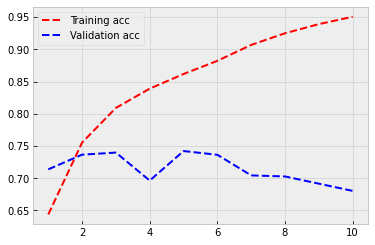
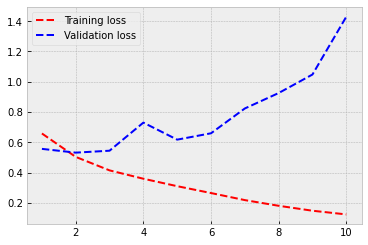
3.2. Recurrent neural networks¶
Next thing that we can try is to use Recurrent neural networks. They are especially efficient for sequences like texts.
from tensorflow.keras.layers import SimpleRNN
Now, instead of a Flatten() layer, we have a SimpleRNN() layer.
model = Sequential()
model.add(Embedding(10000, 100, input_length=200))
model.add(SimpleRNN(100))
model.add(Dense(1, activation='sigmoid'))
model.summary()
Model: "sequential_6"
_________________________________________________________________
Layer (type) Output Shape Param #
=================================================================
embedding_6 (Embedding) (None, 200, 100) 1000000
_________________________________________________________________
simple_rnn_2 (SimpleRNN) (None, 100) 20100
_________________________________________________________________
dense_9 (Dense) (None, 1) 101
=================================================================
Total params: 1,020,201
Trainable params: 1,020,201
Non-trainable params: 0
_________________________________________________________________
Again, we use the GLOVE weights.
# Load GLove wieghts
model.layers[0].set_weights([embedding_matrix])
model.layers[0].trainable = False
model.summary()
Model: "sequential_6"
_________________________________________________________________
Layer (type) Output Shape Param #
=================================================================
embedding_6 (Embedding) (None, 200, 100) 1000000
_________________________________________________________________
simple_rnn_2 (SimpleRNN) (None, 100) 20100
_________________________________________________________________
dense_9 (Dense) (None, 1) 101
=================================================================
Total params: 1,020,201
Trainable params: 20,201
Non-trainable params: 1,000,000
_________________________________________________________________
Nothing has changed in the compile() and fit() -steps.
model.compile(optimizer='rmsprop',loss='binary_crossentropy',metrics=['acc'])
history = model.fit(x_train, y_train,epochs=10,batch_size=32,validation_data=(x_val, y_val))
Epoch 1/10
625/625 [==============================] - 24s 38ms/step - loss: 0.6528 - acc: 0.6186 - val_loss: 0.6096 - val_acc: 0.6786
Epoch 2/10
625/625 [==============================] - 28s 45ms/step - loss: 0.5957 - acc: 0.6887 - val_loss: 0.5760 - val_acc: 0.7066
Epoch 3/10
625/625 [==============================] - 29s 46ms/step - loss: 0.5761 - acc: 0.7047 - val_loss: 0.5618 - val_acc: 0.7272
Epoch 4/10
625/625 [==============================] - 28s 44ms/step - loss: 0.5618 - acc: 0.7147 - val_loss: 0.5384 - val_acc: 0.7428
Epoch 5/10
625/625 [==============================] - 28s 45ms/step - loss: 0.5534 - acc: 0.7227 - val_loss: 0.5499 - val_acc: 0.7248
Epoch 6/10
625/625 [==============================] - 28s 45ms/step - loss: 0.5553 - acc: 0.7169 - val_loss: 0.5894 - val_acc: 0.6918
Epoch 7/10
625/625 [==============================] - 28s 45ms/step - loss: 0.5374 - acc: 0.7325 - val_loss: 0.5234 - val_acc: 0.7494
Epoch 8/10
625/625 [==============================] - 28s 45ms/step - loss: 0.5137 - acc: 0.7479 - val_loss: 0.5315 - val_acc: 0.7498
Epoch 9/10
625/625 [==============================] - 28s 45ms/step - loss: 0.5132 - acc: 0.7489 - val_loss: 0.5621 - val_acc: 0.7284
Epoch 10/10
625/625 [==============================] - 28s 44ms/step - loss: 0.4911 - acc: 0.7660 - val_loss: 0.6154 - val_acc: 0.6886
Well, overfitting is not such a serious problem any more, but the performance is not improving still.
plt.style.use('bmh')
acc = history.history['acc']
val_acc = history.history['val_acc']
loss = history.history['loss']
val_loss = history.history['val_loss']
epochs = range(1, len(acc) + 1)
plt.plot(epochs, acc, 'r--', label='Training accuracy')
plt.plot(epochs, val_acc, 'g', label='Validation accuracy')
plt.legend()
plt.figure()
plt.plot(epochs, loss, 'r--', label='Training loss')
plt.plot(epochs, val_loss, 'g', label='Validation loss')
plt.legend()
plt.show()
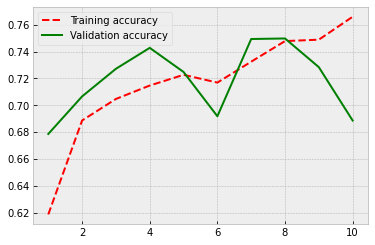
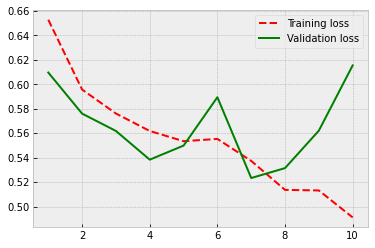
3.3. Long short-term memory¶
As our last idea, we try the LSTM-version of RNN. It has achieved very good performance in practice, so, let’s hope for the best.
from tensorflow.keras.layers import LSTM
model = Sequential()
model.add(Embedding(10000, 100, input_length=200))
model.add(LSTM(100))
model.add(Dense(1, activation='sigmoid'))
model.summary()
Model: "sequential_7"
_________________________________________________________________
Layer (type) Output Shape Param #
=================================================================
embedding_7 (Embedding) (None, 200, 100) 1000000
_________________________________________________________________
lstm (LSTM) (None, 100) 80400
_________________________________________________________________
dense_10 (Dense) (None, 1) 101
=================================================================
Total params: 1,080,501
Trainable params: 1,080,501
Non-trainable params: 0
_________________________________________________________________
# Load GLove wieghts
model.layers[0].set_weights([embedding_matrix])
model.layers[0].trainable = False
model.summary()
Model: "sequential_7"
_________________________________________________________________
Layer (type) Output Shape Param #
=================================================================
embedding_7 (Embedding) (None, 200, 100) 1000000
_________________________________________________________________
lstm (LSTM) (None, 100) 80400
_________________________________________________________________
dense_10 (Dense) (None, 1) 101
=================================================================
Total params: 1,080,501
Trainable params: 80,501
Non-trainable params: 1,000,000
_________________________________________________________________
model.compile(optimizer='rmsprop',loss='binary_crossentropy',metrics=['acc'])
history = model.fit(x_train, y_train,epochs=10,batch_size=32,validation_data=(x_val, y_val))
Epoch 1/10
625/625 [==============================] - 8s 12ms/step - loss: 0.5607 - acc: 0.7138 - val_loss: 0.4525 - val_acc: 0.7844
Epoch 2/10
625/625 [==============================] - 8s 12ms/step - loss: 0.4275 - acc: 0.8061 - val_loss: 0.6175 - val_acc: 0.7750
Epoch 3/10
625/625 [==============================] - 7s 12ms/step - loss: 0.3619 - acc: 0.8458 - val_loss: 0.3399 - val_acc: 0.8524
Epoch 4/10
625/625 [==============================] - 8s 12ms/step - loss: 0.3254 - acc: 0.8616 - val_loss: 0.3284 - val_acc: 0.8594
Epoch 5/10
625/625 [==============================] - 7s 12ms/step - loss: 0.2937 - acc: 0.8752 - val_loss: 0.3091 - val_acc: 0.8728
Epoch 6/10
625/625 [==============================] - 7s 12ms/step - loss: 0.2712 - acc: 0.8884 - val_loss: 0.2998 - val_acc: 0.8716
Epoch 7/10
625/625 [==============================] - 8s 12ms/step - loss: 0.2455 - acc: 0.9002 - val_loss: 0.3528 - val_acc: 0.8560
Epoch 8/10
625/625 [==============================] - 7s 11ms/step - loss: 0.2222 - acc: 0.9116 - val_loss: 0.3320 - val_acc: 0.8600
Epoch 9/10
625/625 [==============================] - 8s 12ms/step - loss: 0.1977 - acc: 0.9230 - val_loss: 0.3221 - val_acc: 0.8760
Epoch 10/10
625/625 [==============================] - 8s 12ms/step - loss: 0.1756 - acc: 0.9322 - val_loss: 0.3241 - val_acc: 0.8684
Finally, we see some progress! Now the accuracy is around 87 %. So, a very significant improvement in performance. For the exact evaluation of performance, we should use a separate test set. However, the validation dataset accuracy gives a good indication of the performance of our model.
plt.style.use('bmh')
acc = history.history['acc']
val_acc = history.history['val_acc']
loss = history.history['loss']
val_loss = history.history['val_loss']
epochs = range(1, len(acc) + 1)
plt.plot(epochs, acc, 'r--', label='Training accuracy')
plt.plot(epochs, val_acc, 'g', label='Validation accuracy')
plt.legend()
plt.figure()
plt.plot(epochs, loss, 'r--', label='Training loss')
plt.plot(epochs, val_loss, 'g', label='Validation loss')
plt.legend()
plt.show()
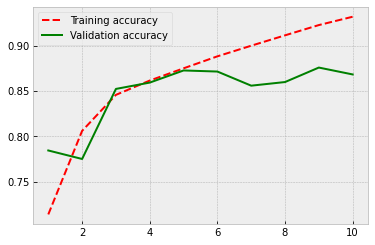
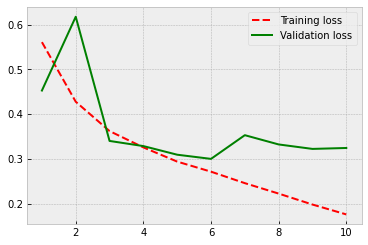
As our final model, let’s test what kind of effect the predetermined weights have for the performance and train an LSTM model from scratch.
model = Sequential()
model.add(Embedding(10000, 32, input_length=200))
model.add(LSTM(32))
model.add(Dense(1, activation='sigmoid'))
model.summary()
Model: "sequential_8"
_________________________________________________________________
Layer (type) Output Shape Param #
=================================================================
embedding_8 (Embedding) (None, 200, 32) 320000
_________________________________________________________________
lstm_1 (LSTM) (None, 32) 8320
_________________________________________________________________
dense_11 (Dense) (None, 1) 33
=================================================================
Total params: 328,353
Trainable params: 328,353
Non-trainable params: 0
_________________________________________________________________
model.compile(optimizer='rmsprop',loss='binary_crossentropy',metrics=['acc'])
history = model.fit(x_train, y_train,epochs=10,batch_size=32,validation_data=(x_val, y_val))
Epoch 1/10
625/625 [==============================] - 7s 11ms/step - loss: 0.4124 - acc: 0.8138 - val_loss: 0.3248 - val_acc: 0.8686
Epoch 2/10
625/625 [==============================] - 6s 10ms/step - loss: 0.2546 - acc: 0.9002 - val_loss: 0.3000 - val_acc: 0.8792
Epoch 3/10
625/625 [==============================] - 7s 11ms/step - loss: 0.2125 - acc: 0.9188 - val_loss: 0.3030 - val_acc: 0.8734
Epoch 4/10
625/625 [==============================] - 7s 11ms/step - loss: 0.1897 - acc: 0.9281 - val_loss: 0.3205 - val_acc: 0.8782
Epoch 5/10
625/625 [==============================] - 8s 14ms/step - loss: 0.1685 - acc: 0.9387 - val_loss: 0.3162 - val_acc: 0.8716
Epoch 6/10
625/625 [==============================] - 7s 11ms/step - loss: 0.1592 - acc: 0.9424 - val_loss: 0.3449 - val_acc: 0.8752
Epoch 7/10
625/625 [==============================] - 6s 10ms/step - loss: 0.1416 - acc: 0.9490 - val_loss: 0.3605 - val_acc: 0.8742
Epoch 8/10
625/625 [==============================] - 7s 11ms/step - loss: 0.1298 - acc: 0.9536 - val_loss: 0.3191 - val_acc: 0.8720
Epoch 9/10
625/625 [==============================] - 7s 11ms/step - loss: 0.1181 - acc: 0.9588 - val_loss: 0.3642 - val_acc: 0.8778
Epoch 10/10
625/625 [==============================] - 8s 13ms/step - loss: 0.1088 - acc: 0.9633 - val_loss: 0.3751 - val_acc: 0.8652
Because there are no locked parameters, the number of trainable parameters increases, and this causes some overfitting. However, the performance is at the same level as in the previous model. So, the predetermined weights do not appear to improve the accuracy, but they help at fighting overfitting.
plt.style.use('bmh')
acc = history.history['acc']
val_acc = history.history['val_acc']
loss = history.history['loss']
val_loss = history.history['val_loss']
epochs = range(1, len(acc) + 1)
plt.plot(epochs, acc, 'r--', label='Training accuracy')
plt.plot(epochs, val_acc, 'g', label='Validation accuracy')
plt.legend()
plt.figure()
plt.plot(epochs, loss, 'r--', label='Training loss')
plt.plot(epochs, val_loss, 'g', label='Validation loss')
plt.legend()
plt.show()
